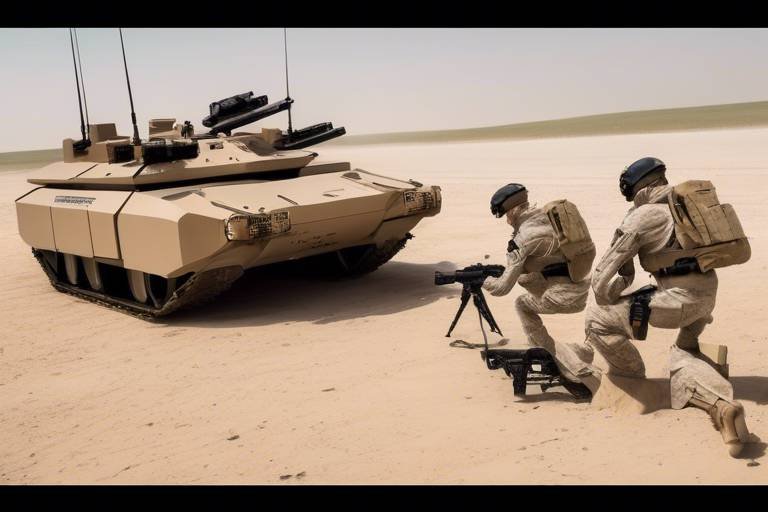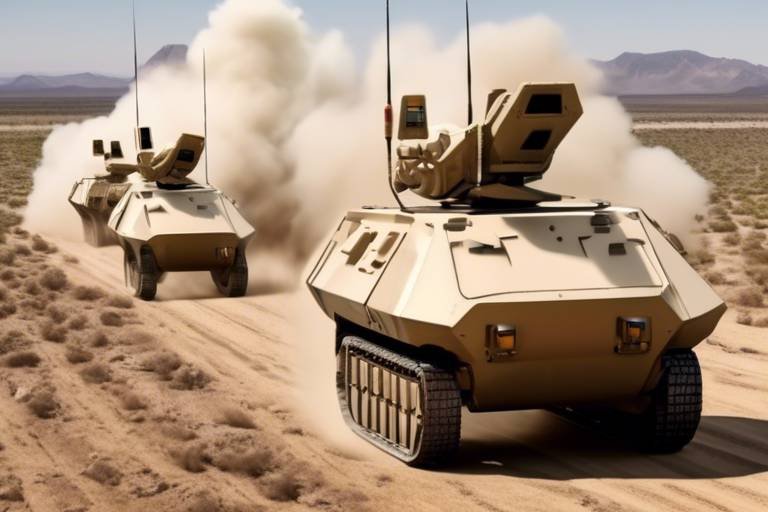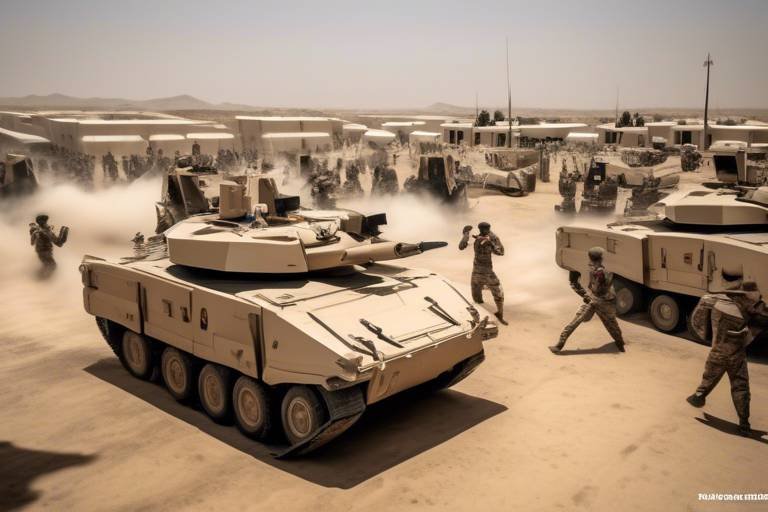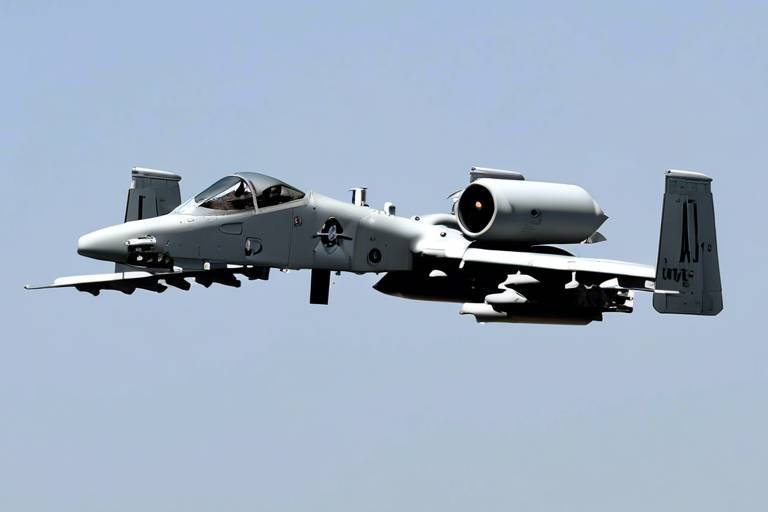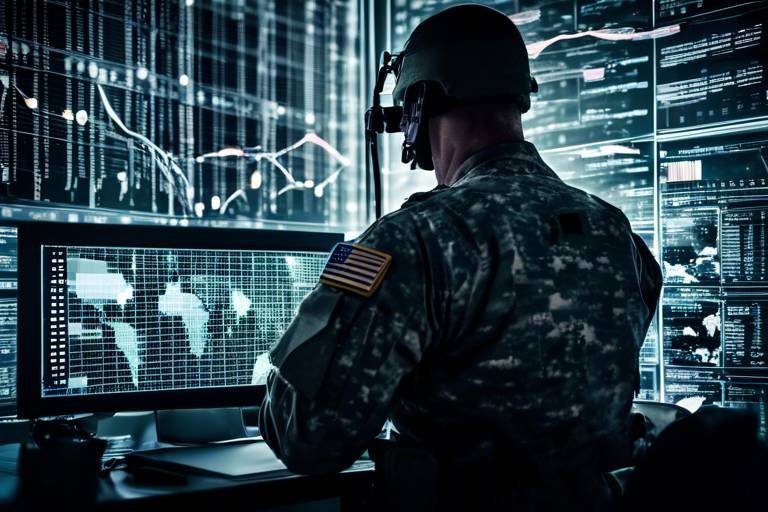The Role of International Collaboration in Defense Innovation
In today's rapidly evolving geopolitical landscape, the significance of international partnerships in defense innovation cannot be overstated. Nations are increasingly recognizing that the challenges they face—ranging from cyber threats to terrorism—are not confined by borders. This realization has sparked a new era of collaboration, where countries pool their resources, knowledge, and expertise to enhance their military capabilities and ensure national security. Just as a symphony orchestra achieves harmony through the collaboration of diverse instruments, so too can nations achieve unparalleled strength through cooperative defense efforts.
Imagine a world where countries work together, sharing their technological advancements and innovative strategies, much like a team of athletes combining their unique skills to win a championship. This collaborative approach not only fosters innovation but also creates a united front against common threats. By leveraging each other's strengths, nations can develop cutting-edge technologies that may have been unattainable if pursued in isolation.
For instance, the integration of artificial intelligence (AI) and robotics into defense systems is a prime example of how international collaboration can lead to groundbreaking advancements. Countries can share research findings, experiment with new applications, and ultimately accelerate the deployment of these technologies in military operations. This is not just about keeping pace with adversaries; it's about staying several steps ahead in a game where the stakes are incredibly high.
Furthermore, international collaboration in defense innovation extends beyond technological advancements. It encompasses the sharing of best practices in military strategy, logistics, and even humanitarian efforts. When nations come together to tackle global challenges, they create a network of support that can respond more effectively to crises. Just like a community that bands together during a natural disaster, countries can pool their resources and expertise to address security threats and foster stability on a global scale.
However, achieving effective collaboration is not without its challenges. Differences in political agendas, cultural perspectives, and operational protocols can complicate partnerships. Yet, the potential benefits far outweigh these hurdles. By establishing clear communication channels and mutual trust, nations can navigate these complexities and forge strong alliances that enhance their defense capabilities.
In conclusion, the role of international collaboration in defense innovation is pivotal for shaping a secure future. As nations continue to face multifaceted threats, the need for cooperation becomes increasingly urgent. Just as a single candle can light a dark room, a united front of nations can illuminate the path toward a safer world. Embracing this collaborative spirit will not only enhance military effectiveness but also promote global peace and security.
- Why is international collaboration important in defense?
International collaboration allows nations to pool resources, share knowledge, and tackle common threats more effectively, leading to enhanced security and innovation. - What are some examples of successful international defense collaborations?
Joint military exercises, collaborative research and development projects, and information-sharing initiatives are key examples of successful collaborations in defense. - How does cybersecurity benefit from international collaboration?
By sharing intelligence and best practices, nations can strengthen their cybersecurity measures and protect critical infrastructure from sophisticated attacks. - What challenges do countries face in collaborating on defense?
Diverse political agendas, cultural differences, and varying operational protocols can complicate international defense collaborations.

The Importance of Defense Innovation
In today's rapidly evolving world, defense innovation plays a crucial role in shaping national security and enhancing military capabilities. As threats become more sophisticated and unpredictable, the need for continuous advancements in defense technologies has never been more critical. Imagine a chess game where the opponent is always a step ahead; without innovation, nations risk falling behind, leaving their security vulnerable to emerging threats.
Defending against potential adversaries requires not just traditional military strength but also a robust arsenal of cutting-edge technologies. This is where defense innovation steps in, acting as the backbone of modern military strategies. It encompasses a wide array of advancements, from artificial intelligence and cyber capabilities to advanced weaponry and surveillance systems. The integration of these technologies into defense strategies ensures that nations can respond effectively to a myriad of challenges, whether they stem from conventional warfare or asymmetric threats.
Furthermore, the landscape of global security is constantly shifting. Factors such as geopolitical tensions, economic instability, and the rise of non-state actors demand that nations remain vigilant and adaptable. For instance, consider the impact of terrorism and cyber warfare; these threats do not respect national borders, making it imperative for countries to innovate collaboratively. By pooling resources and expertise, nations can develop comprehensive strategies that not only address current challenges but also anticipate future ones.
Moreover, the investment in defense innovation is not just about maintaining military superiority; it is also about fostering economic growth and technological advancement. A robust defense sector can drive innovation across other industries, creating jobs and stimulating economic development. Countries that prioritize defense innovation often find themselves at the forefront of technological breakthroughs that benefit both national security and civilian applications.
In summary, the importance of defense innovation cannot be overstated. It is a vital component of national security that enables countries to adapt to a complex and ever-changing global landscape. By embracing new technologies and fostering international collaboration, nations can better equip themselves to face the challenges of tomorrow. As we look to the future, it is clear that innovation will be the key to unlocking new possibilities in defense and security.

Global Defense Challenges
In today's interconnected world, the landscape of global defense is more complex than ever. Nations are no longer just facing isolated threats; instead, they are confronted with a myriad of challenges that require a unified approach. The rise of cyber threats, the persistent shadow of terrorism, and the increasing geopolitical tensions are just a few of the hurdles that demand international collaboration. As we navigate through these turbulent waters, it’s essential to recognize that no single country can tackle these issues alone. The stakes are high, and the need for a coordinated defense strategy has never been more pressing.
Consider the realm of cybersecurity, where the battlefield is often invisible. Cyberattacks can originate from anywhere in the world, targeting critical infrastructure, government systems, and private enterprises. This reality amplifies the need for nations to band together, sharing intelligence and resources to fortify their defenses against these sophisticated threats. A single breach can have cascading effects, making it imperative for countries to establish a united front. The question arises: how can we enhance our defenses and ensure the safety of our citizens in this digital age?
Moreover, the threat of terrorism continues to evolve, with extremist groups leveraging technology to spread their ideologies and coordinate attacks across borders. This necessitates a collaborative approach where intelligence sharing and joint operations become the norm rather than the exception. Countries must work together to dismantle terrorist networks, disrupt financing, and counteract propaganda. The reality is that a threat to one nation is a threat to all, making international cooperation not just beneficial but essential.
Geopolitical tensions further complicate the defense landscape. Nations are often at odds over territorial disputes, resource allocation, and political ideologies. In such an environment, establishing strong alliances and partnerships can serve as a deterrent against potential aggressors. Through joint exercises and collaborative defense initiatives, countries can demonstrate their solidarity and readiness to respond to any threats that may arise. This is not just about military might; it's about fostering trust and understanding among nations to create a safer world.
In summary, the global defense challenges we face today are multifaceted and require an innovative response. By coming together, sharing knowledge and resources, and developing a cohesive strategy, nations can enhance their security and resilience. The future of defense lies in collaboration—an approach that not only addresses current threats but also anticipates those on the horizon. Are we ready to embrace this challenge and work together for a more secure world?
- What are the main global defense challenges? The primary challenges include cybersecurity threats, terrorism, and geopolitical tensions that require international collaboration.
- Why is international collaboration important in defense? It allows nations to share intelligence, resources, and strategies to effectively combat threats that transcend borders.
- How do joint military exercises enhance global security? They improve interoperability among allied forces and strengthen relationships, ensuring readiness to respond to potential threats.
- What role do emerging technologies play in defense? Innovations like artificial intelligence and robotics are reshaping defense capabilities, and international collaboration accelerates their development.

Cybersecurity Threats
In the age of digital transformation, have emerged as one of the most pressing issues facing nations worldwide. As our reliance on technology grows, so does the sophistication of cyberattacks. From state-sponsored hacking to ransomware attacks targeting critical infrastructure, the landscape of cybersecurity is constantly evolving, presenting new challenges that demand immediate attention. Imagine a world where a single cyber incident could cripple an entire nation’s power grid or disrupt financial systems—this is not just a hypothetical scenario; it’s a reality we must prepare for.
International collaboration plays a crucial role in addressing these threats. By pooling resources, knowledge, and expertise, nations can create a robust defense against cyber adversaries. The importance of this collaboration cannot be overstated, as cyber threats are not confined by borders. A successful cyberattack on one nation can have ripple effects, impacting economies and security across the globe. Therefore, it is essential for countries to work together, sharing intelligence and developing comprehensive strategies to combat these threats.
To illustrate the impact of cybersecurity threats, consider the following types of attacks that nations face:
- Phishing Attacks: Deceptive emails that trick individuals into revealing sensitive information.
- Ransomware: Malicious software that locks users out of their systems until a ransom is paid.
- Denial of Service (DoS): Attacks that overwhelm systems, rendering them inoperable.
- State-Sponsored Hacking: Cyber espionage conducted by nation-states targeting strategic assets.
These threats highlight the urgency of establishing effective cybersecurity measures through international partnerships. Nations can benefit from sharing best practices, developing joint training programs, and conducting collaborative research to enhance their cybersecurity frameworks. For instance, countries can work together to create joint cyber defense initiatives that focus on real-time information sharing and coordinated responses to incidents.
Moreover, the development of information sharing protocols is essential for fostering trust and ensuring that sensitive data can be exchanged securely among international partners. Such protocols facilitate timely communication during cyber incidents, allowing nations to respond swiftly and effectively to neutralize threats before they escalate. By establishing a framework for secure communication, countries can enhance their collective defense capabilities against cyber threats.
In conclusion, the landscape of cybersecurity is fraught with challenges that require a united front. As we navigate this complex terrain, international collaboration will be the cornerstone of our defense strategy. By working together, sharing knowledge, and developing innovative solutions, nations can not only protect their own interests but also contribute to a safer global digital environment.

Joint Cyber Defense Initiatives
In an era where cyber threats loom larger than ever, the importance of cannot be overstated. These collaborations among nations are not just about sharing resources; they are about uniting against a common enemy. Imagine a world where each country operates in isolation against cybercriminals and hackers. It would be like a group of friends trying to fend off a bully, each one too afraid to back the other up. However, when nations come together, they create a formidable shield that enhances their collective security.
One of the most significant advantages of these initiatives is the ability to share intelligence. Countries can pool their knowledge about emerging threats, which not only speeds up the response time but also enhances the effectiveness of their defenses. For instance, consider a scenario where one nation detects a new type of malware. By sharing this information with its allies, they can all take preemptive measures to protect their critical infrastructure. This is akin to a neighborhood watch program, where everyone looks out for one another, ensuring that no one is caught off guard.
Moreover, joint cyber defense initiatives often lead to the development of innovative solutions that might not have been possible if each nation had worked in isolation. Collaborative projects can include the creation of advanced cybersecurity tools or protocols that benefit all participants. For example, countries might work together to develop a shared cybersecurity framework that can be adapted to their specific needs while still maintaining a unified approach to defense. This collaboration not only fosters innovation but also builds trust among nations, paving the way for future partnerships.
To illustrate the effectiveness of these initiatives, let’s take a look at a few successful examples:
| Initiative | Countries Involved | Outcome |
|---|---|---|
| Cyber Defense Exercise | USA, UK, Canada, Australia | Enhanced interoperability and shared best practices |
| Joint Threat Intelligence Sharing | EU Nations | Improved response times to cyber incidents |
| Collaborative Malware Analysis | Japan, South Korea, India | Development of a comprehensive malware detection tool |
These examples highlight how nations can achieve remarkable outcomes by working together. The combined efforts not only strengthen their individual defenses but also contribute to a more secure global cyber environment. As we continue to face increasingly sophisticated cyber threats, it is clear that international collaboration will be a key component in the fight against cybercrime.
In conclusion, joint cyber defense initiatives are more than just strategic partnerships; they represent a commitment to safeguarding our digital future. By collaborating, nations can create a robust defense mechanism that not only protects their own interests but also contributes to global security. As the saying goes, "United we stand, divided we fall," and this couldn't be truer in the realm of cybersecurity.
- What are joint cyber defense initiatives? Joint cyber defense initiatives are collaborative efforts among nations to enhance their cybersecurity capabilities through shared intelligence, resources, and innovative solutions.
- Why is international collaboration important in cybersecurity? International collaboration is essential because cyber threats are global in nature, and a unified response is more effective than isolated efforts.
- How do joint initiatives improve cybersecurity? They improve cybersecurity by allowing countries to share information about threats, develop joint strategies, and create advanced security technologies.

Information Sharing Protocols
In the realm of international defense, effective information sharing is not just a luxury; it's a necessity. As nations face increasingly sophisticated threats, the ability to communicate and exchange critical data swiftly can mean the difference between thwarting an attack and suffering catastrophic consequences. Imagine a world where vital intelligence is stuck in silos, unable to flow freely between countries that are on the front lines of defense. This scenario is not just inefficient; it can be downright dangerous.
To tackle these challenges, various have been developed. These protocols establish guidelines and frameworks that facilitate secure communication between nations. They ensure that sensitive information is shared in a manner that protects national security while promoting collaboration. One of the most significant advancements in this area has been the establishment of secure communication channels that allow for real-time data exchange. This capability is crucial when responding to urgent threats, such as cyberattacks or terrorist activities.
Moreover, the implementation of standardized protocols across different nations enhances interoperability. This means that when one country gathers intelligence, it can share that information seamlessly with its allies. For instance, NATO has developed specific protocols that member nations follow to ensure that intelligence is shared efficiently and securely. This not only builds trust among allies but also creates a unified front against common threats.
Another vital aspect of these protocols is the use of advanced technologies. With the rise of artificial intelligence and machine learning, nations can now analyze vast amounts of data quickly and accurately. This capability allows for better predictive analysis and threat assessment. Countries are increasingly investing in platforms that enable them to share insights derived from these technologies, thereby enhancing their collective defense posture.
In addition to formal protocols, informal networks also play a crucial role in information sharing. These networks often consist of defense experts, analysts, and policymakers who communicate regularly to discuss emerging threats and share insights. This informal exchange of information can be just as valuable as formal channels, as it fosters a culture of collaboration and trust among nations.
However, the implementation of these information sharing protocols is not without its challenges. Issues such as data privacy, legal constraints, and differing national policies can complicate the process. To address these obstacles, nations must work together to establish common ground and develop mutually acceptable guidelines. This requires a commitment to transparency and a willingness to compromise on certain issues.
In conclusion, effective information sharing protocols are the backbone of international defense collaboration. They enable nations to pool their intelligence resources, respond to threats more efficiently, and ultimately enhance global security. As the landscape of defense continues to evolve, the importance of these protocols will only grow, making it imperative for nations to prioritize their development and implementation.

Emerging Technologies
In today's rapidly evolving world, are not just buzzwords; they are the cornerstone of modern defense strategies. Innovations such as artificial intelligence (AI), robotics, and quantum computing are revolutionizing how nations approach security and military operations. Imagine a battlefield where decisions can be made in milliseconds, thanks to AI algorithms analyzing vast amounts of data. This is not science fiction; this is the future of defense innovation. The ability to harness these technologies through international collaboration can significantly enhance a nation's military capabilities and overall security posture.
One of the most exciting aspects of emerging technologies is their potential to create a synergistic effect when nations work together. For instance, countries can share their expertise and resources to develop advanced AI systems that improve threat detection and response times. This cooperative approach not only accelerates the development of these technologies but also ensures that they are deployed effectively across different military branches and allied forces. The pooling of resources leads to a more robust defense infrastructure that can adapt to new challenges swiftly.
Let's take a closer look at some of the key emerging technologies that are shaping the future of defense:
- Artificial Intelligence: AI can analyze data patterns to predict potential threats and optimize military operations.
- Robotics: Autonomous drones and robotic systems can perform surveillance, reconnaissance, and even combat missions, reducing the risk to human soldiers.
- Quantum Computing: This technology promises to revolutionize data encryption and processing, making communications more secure against cyber threats.
Moreover, international partnerships can facilitate the sharing of best practices and lessons learned in the deployment of these technologies. For example, through joint research and development initiatives, nations can collaboratively create cutting-edge solutions that address shared security concerns. This not only enhances the technological capabilities of each nation involved but also fosters a sense of global solidarity in the face of common threats.
As we move forward, it is essential to recognize the significance of establishing regulatory frameworks that govern the use of these technologies in defense. By collaborating internationally on ethical standards and operational protocols, countries can ensure that emerging technologies are utilized responsibly and effectively. This proactive approach will help mitigate risks associated with the misuse of advanced technologies, such as AI-driven weapon systems or autonomous military operations.
In summary, the role of international collaboration in advancing emerging technologies cannot be overstated. As nations come together to share knowledge, resources, and expertise, they not only enhance their own military capabilities but also contribute to a more secure and stable global environment. The future of defense innovation lies in our ability to work together and leverage these transformative technologies for the greater good.
- What are some examples of emerging technologies in defense? Emerging technologies in defense include artificial intelligence, robotics, and quantum computing.
- How does international collaboration enhance defense innovation? By pooling resources and expertise, nations can accelerate the development and deployment of advanced technologies, leading to improved security.
- What are the ethical considerations surrounding emerging defense technologies? Establishing regulatory frameworks and ethical standards is crucial to ensure responsible use and mitigate risks associated with advanced technologies.

Successful International Defense Collaborations
In today's interconnected world, the significance of international defense collaborations cannot be overstated. These partnerships are not just about sharing resources; they represent a collective commitment to enhancing global security and addressing common threats. By pooling expertise and technology, nations can achieve breakthroughs that would be impossible to realize in isolation. For instance, consider the collaborative efforts in developing advanced military technologies. Countries like the United States, the United Kingdom, and Australia have joined forces to create state-of-the-art defense systems that enhance their military capabilities while fostering interoperability among their forces.
One of the most notable examples of successful collaboration is the F-35 Lightning II program. This multinational initiative involves multiple countries, including the U.S., UK, Italy, and Japan, working together to develop a next-generation stealth fighter. The program not only showcases cutting-edge technology but also emphasizes the importance of shared investment and risk. Through this partnership, each nation benefits from shared knowledge, reduced costs, and a unified approach to defense. The F-35 has become a symbol of how international collaboration can lead to remarkable advancements in military aviation.
Moreover, joint military exercises serve as another vital aspect of these collaborations. For example, the RIMPAC (Rim of the Pacific Exercise) is the largest international maritime exercise, bringing together naval forces from around the globe. These exercises are crucial for building trust and improving operational readiness among allied nations. They allow forces to practice working together in various scenarios, ensuring that when the need arises, they can respond effectively as a cohesive unit. The lessons learned and relationships built during such exercises can be invaluable during actual crises.
In addition to military exercises, collaborative research and development (R&D) projects have proven to be game-changers in defense innovation. Countries often face similar challenges, whether in cybersecurity or developing new weapon systems. By collaborating on R&D, nations can leverage their unique strengths and address common vulnerabilities more effectively. For instance, the European Union's Permanent Structured Cooperation (PESCO) initiative encourages member states to work together on defense projects, fostering innovation and ensuring that Europe remains at the forefront of defense technology.
Ultimately, successful international defense collaborations hinge on effective communication and trust among partners. As nations navigate complex geopolitical landscapes, the ability to share intelligence and resources becomes paramount. For instance, the Five Eyes alliance, comprising Australia, Canada, New Zealand, the UK, and the US, exemplifies how intelligence sharing can enhance national security. By working together, these nations can respond to threats more swiftly and effectively, creating a safer global environment.
In conclusion, the landscape of defense is rapidly evolving, and international collaborations are essential for keeping pace with emerging threats. As nations come together to share knowledge, resources, and technology, they not only enhance their own capabilities but also contribute to a more secure world. The future of defense innovation lies in these partnerships, where unity and cooperation pave the way for groundbreaking advancements.
- What is the significance of international defense collaborations?
International defense collaborations enhance global security, enable resource sharing, and foster innovation by pooling expertise and technology among nations. - Can you provide an example of a successful defense collaboration?
The F-35 Lightning II program is a prime example, involving multiple countries working together to develop advanced military technology. - How do joint military exercises contribute to defense collaboration?
Joint military exercises, like RIMPAC, build trust and improve operational readiness among allied forces, ensuring effective responses in crises. - What role does research and development play in defense collaborations?
Collaborative R&D projects allow nations to leverage unique strengths and address common challenges, leading to innovative defense solutions.

Joint Military Exercises
Joint military exercises are more than just a show of force; they are a crucial element in enhancing the operational readiness and interoperability of allied forces. Imagine a team of athletes training together for a championship; they must learn to work in sync, understand each other’s strengths and weaknesses, and develop strategies that leverage their collective capabilities. Similarly, joint military exercises allow nations to practice their tactics, refine their communication, and build trust among their armed forces.
These exercises serve multiple purposes. First, they enhance interoperability, which is essential when forces from different countries must work together in real-world scenarios. When soldiers from various nations engage in joint training, they learn to operate their equipment and communicate effectively under pressure. This collaboration is vital, especially in complex operations where every second counts. For instance, during humanitarian missions or peacekeeping operations, the ability to coordinate seamlessly can mean the difference between success and failure.
Moreover, joint military exercises provide an opportunity to test new tactics and technologies. Countries can experiment with advanced equipment and strategies in a controlled environment, allowing them to identify potential weaknesses and areas for improvement. This aspect of collaboration is particularly important as military technology evolves rapidly. For example, during the recent “Defender Europe” exercise, NATO allies tested new cyber defense techniques alongside traditional military maneuvers, showcasing the integration of modern warfare tactics.
In addition to operational benefits, these exercises foster strong diplomatic ties. When nations come together for a common goal, they build relationships that extend beyond military cooperation. The camaraderie developed during these exercises can lead to greater political and economic partnerships, reinforcing the notion that defense collaboration is not just about military might but also about fostering peace and stability in a volatile world.
Furthermore, joint military exercises can serve as a powerful deterrent against potential aggressors. When adversaries see allied forces conducting large-scale operations together, it sends a clear message: these nations are united and prepared to defend one another. This show of strength can help maintain regional stability and discourage hostile actions.
To illustrate the impact of joint military exercises, let’s take a look at a few notable examples:
| Exercise Name | Participating Nations | Year | Key Focus |
|---|---|---|---|
| RIMPAC | USA, Australia, Canada, Japan, and others | Every two years since 1971 | Maritime security and disaster response |
| Defender Europe | NATO Allies | 2020, 2021 | Land and air operations, including cyber defense |
| Joint Warrior | UK, France, Germany, and others | Twice a year since 2001 | Multi-domain operations |
In conclusion, joint military exercises are a vital tool for nations to enhance their defense capabilities, build trust, and deter potential threats. As global security challenges continue to evolve, these collaborative efforts will remain essential in ensuring that allied forces are prepared to respond effectively to any situation. The bonds formed during these exercises not only strengthen military alliances but also contribute to a more secure and stable world.
- What are joint military exercises? Joint military exercises are coordinated training events involving armed forces from multiple nations, aimed at improving interoperability, operational readiness, and fostering diplomatic relationships.
- Why are joint military exercises important? They enhance collaboration among allied forces, test new tactics and technologies, and serve as a deterrent against potential aggressors.
- How often do these exercises occur? The frequency varies by exercise; some are held annually, while others take place every few years, depending on the objectives and participating nations.
- Can civilians participate in these exercises? Generally, joint military exercises are conducted by military personnel, but some may include civilian agencies, especially in humanitarian and disaster response scenarios.

Collaborative Research and Development
In today’s rapidly evolving world, the need for collaborative research and development (R&D) in defense has never been more critical. As nations face increasingly complex security challenges, pooling resources and expertise becomes a strategic necessity. Imagine trying to solve a complex puzzle alone; it’s not only daunting but often leads to incomplete solutions. However, when countries come together, they can share insights, technologies, and capabilities, creating a more comprehensive picture of what needs to be done to enhance security. This collaboration not only accelerates the pace of innovation but also ensures that all participating nations benefit from advancements in defense technologies.
One of the most significant advantages of collaborative R&D is the ability to leverage diverse perspectives and expertise. For instance, a project involving multiple countries can bring together scientists, engineers, and military experts who each contribute unique insights. This melting pot of ideas can lead to breakthroughs that might not have been possible in isolation. Moreover, shared funding means that nations can tackle larger projects that would be financially unfeasible alone. By distributing the financial burden, countries can invest more in cutting-edge technologies such as artificial intelligence, robotics, and advanced materials.
To illustrate the impact of collaborative R&D, consider the partnerships formed through initiatives like the European Defense Fund and the Joint Strike Fighter Program. These programs have not only fostered innovation but also strengthened alliances among participating nations. The table below highlights some key collaborative projects and their contributions to defense innovation:
| Project Name | Participating Countries | Key Innovations |
|---|---|---|
| Joint Strike Fighter | USA, UK, Australia, Canada, and others | F-35 Lightning II, advanced stealth technology |
| European Defense Fund | EU Member States | Next-generation drone systems, cyber defense technologies |
| International Space Station | USA, Russia, Europe, Japan, Canada | Satellite technology, space exploration capabilities |
Furthermore, collaborative R&D can enhance the speed of technological deployment. When nations work together, they can quickly test and validate new technologies, making it easier to implement solutions that address pressing defense needs. This is particularly vital in areas such as cybersecurity and biodefense, where threats can emerge suddenly and evolve rapidly. By sharing research findings and operational experiences, countries can adapt more swiftly to new threats and improve their defensive postures.
However, collaboration in defense R&D is not without its challenges. Issues such as intellectual property rights, differing national regulations, and varying strategic priorities can complicate partnerships. To mitigate these challenges, nations must establish clear frameworks for collaboration that outline roles, responsibilities, and expectations. Effective governance structures are essential to ensure that all partners are aligned and that the benefits of collaboration are equitably shared.
In conclusion, collaborative research and development in defense is not just a trend; it is a necessary evolution in how nations approach security challenges. By working together, countries can innovate faster and more effectively, ensuring they remain prepared for the threats of today and tomorrow. As the global landscape continues to shift, those who embrace collaboration will undoubtedly lead the way in defense innovation.
- What is collaborative research and development in defense? Collaborative R&D in defense refers to the joint efforts of multiple nations or organizations to innovate and develop new defense technologies and solutions.
- Why is international collaboration important in defense? International collaboration is essential for pooling resources, sharing expertise, and addressing complex security challenges that no single nation can tackle alone.
- What are some examples of successful collaborative defense projects? Notable examples include the Joint Strike Fighter Program and the European Defense Fund, which have led to significant advancements in military technology.
- What challenges do countries face in collaborative R&D? Challenges include intellectual property rights, differing regulations, and aligning strategic priorities among partner nations.
Frequently Asked Questions
- What is the significance of international collaboration in defense innovation?
International collaboration in defense innovation is crucial because it allows nations to pool their resources, share knowledge, and develop advanced technologies more effectively. By working together, countries can address common threats and enhance their military capabilities, ultimately leading to improved global security.
- How do emerging technologies impact defense strategies?
Emerging technologies, such as artificial intelligence and robotics, are revolutionizing defense strategies by enabling faster decision-making, enhancing operational efficiency, and improving situational awareness. International collaboration accelerates the development of these technologies, ensuring that nations remain competitive and capable of addressing evolving threats.
- What role do joint military exercises play in international defense collaboration?
Joint military exercises are essential for fostering interoperability among allied forces. These exercises enhance readiness and strengthen relationships between nations by allowing military personnel to practice working together in various scenarios, which is vital for effective coordination during real-world operations.
- How can countries improve their cybersecurity through collaboration?
Countries can improve their cybersecurity by engaging in joint initiatives that focus on sharing intelligence, developing best practices, and establishing secure communication protocols. Collaborative efforts enable nations to respond more effectively to cyber threats and protect critical infrastructure from sophisticated attacks.
- What are some examples of successful international defense collaborations?
Successful international defense collaborations include joint research and development projects, collaborative military exercises, and shared cybersecurity initiatives. These partnerships have led to groundbreaking advancements in defense technology and have significantly improved global security.
- Why is information sharing important in defense collaboration?
Information sharing is vital in defense collaboration because it allows countries to respond quickly to emerging threats. By establishing secure communication protocols, nations can exchange critical data and intelligence, ensuring that all partners are informed and prepared to act when necessary.


